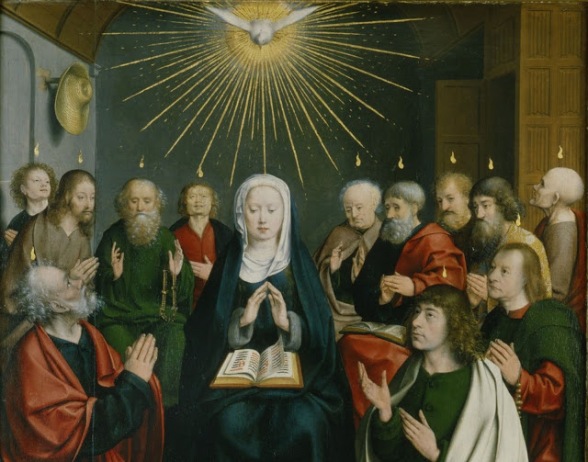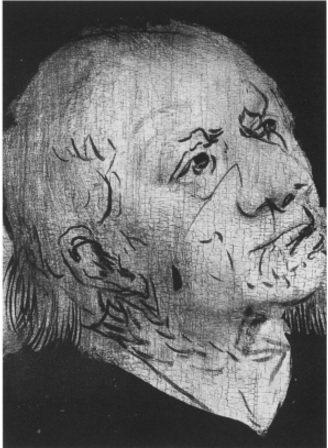Today we celebrate Pentecost Sunday:
When the time for Pentecost was fulfilled,
they were all in one place together.
And suddenly there came from the sky
a noise like a strong driving wind,
and it filled the entire house in which they were.
Then there appeared to them tongues as of fire,
which parted and came to rest on each one of them.
And they were all filled with the Holy Spirit
and began to speak in different tongues,
as the Spirit enabled them to proclaim.
Now there were devout Jews from every nation under heaven
staying in Jerusalem.
At this sound, they gathered in a large crowd,
but they were confused
because each one heard them speaking in his own language.
They were astounded, and in amazement they asked,
“Are not all these people who are speaking Galileans?
Then how does each of us hear them in his native language?
We are Parthians, Medes, and Elamites,
inhabitants of Mesopotamia, Judea and Cappadocia,
Pontus and Asia, Phrygia and Pamphylia,
Egypt and the districts of Libya near Cyrene,
as well as travelers from Rome,
both Jews and converts to Judaism, Cretans and Arabs,
yet we hear them speaking in our own tongues
of the mighty acts of God.”
Acts 2:1-1
Over the past nine days we’ve viewed images of this event as we prayed the Pentecost Novena. Our final image today is from a magnificent carved Altarpiece with paintings attached to its wings that can only be seen when the Altarpiece is opened for display.
The Kalkar Altarpiece takes pride of place on the high altar in the Church of St. Nicholas at Kalkar, Germany known for its abundance of skillfully carved wooden altarpieces.
The shrine’s wood carvings were created by Arnt Van Zwolle while Jan Joest painted the accompanying panels in 1505-1508. The Pentecost painting is situated at the lower right, next to the Dormition of the Virgin. These paintings are the conclusion of the Passion cycle, which was only displayed on feast days in the Church calendar. Joest’s choice of the Dormition rather than the Ascension as the final image may be a result of the veneration of the Virgin in this region of the Rhine.
You’ll note that Mary is not mentioned in the passage from Acts describing Pentecost, yet she is featured in many portrayals of the event, including this altarpiece. Most (though not all) early depictions of Pentecost show only the Apostles. Mary’s image becomes ubiquitous in Pentecost depictions once the development of the Rosary occurs, which had a special significance at Kalkar, as I’ll explain later.
Infrared photography of the painted altarpiece panels has shown that Joest made preparatory sketches of the faces. Some of these were executed roughly, merely as placeholders for the heads to be painted in. A few, though, were drafted more carefully and show distinct features and personality that were likely modeled after actual individuals.
By examing the panels and underdrawings, scholar Lioba Schollmeyer has identified the man in the Dormition clothed in green robes and seated at the center holding the large Rosary as Bishop Jacobus de Ridder. He was one of the town of Kalkar’s prominent sons, whose wealthy family may have financed the altarpiece. He was ordained Bishop of Hebron as well as Suffragan of Utrecht in 1506, the only native of Kalkar to receive this office for two hundred years. He is also depicted in the Descent of the Holy Spirit at the right with a green cloak over a red gown, with the rosary over his wrist.
The prominence of the Rosary in both these paintings is also significant, and not only because of the regional veneration of the Blessed Mother. A Carthusian monk, Heinrich Egher von Calcar, another native son of the town where our altarpiece resides, introduced the recitation of the Our Father for every ten Hail Marys into the Rosary. The Rosary became an immensely popular devotion in Germany, and this version developed by a monk originally from Kalkar, is still recited to this day.
So it is fitting for this altarpiece in the town of Kalkar that Joest features both the Rosary and one of the prominent scions of the family who may have financed the altarpiece. It would have been a source of devotion and prayer when it was opened on Holy Days, offering this remote Rhineland town pride in their heritage.







Comparing the cropped panel, with its clarity, verse the hole altar piece, with multiple panels and cravings, brings up an issue that I have with many of the church displays. I am often overwhelmed with the whole setting with such abundance of images to view, while the presentation in books and websites highlights specific pieces of art.
But, I also reflect on this concept when I visit a museum or gallary, observing people passing by a work of art in less that a fraction of a minute. How many hours did the artist spend constructing the composition, colors, and textures that I might barely glance at before moving on.
However, churches and altar pieces are designed to be reflected on. Not passed by with bucket-list appreciation. Of the 3 dozen or so churches that we visited in Rome last year, those that stand out in my memory, are those that we visited during the mass. We sat, quietly, for the duration of the service and just absorbed the surroundings.
The faboulous Caravaggio of St. Paul’s conversion in St. Maria de Popolo, viewed for 2 minutes between putting Euro’s in the box to keep the lights on and priest ushering us out because the church was closing, and my travel companion wanting to know where the scene from Angles and Demons occured in that church (the Chigi chapel), that was a moment of reflection missed.
Oscar
LikeLiked by 1 person